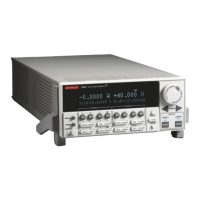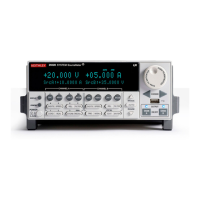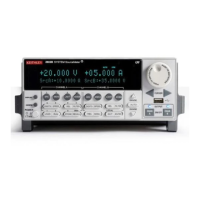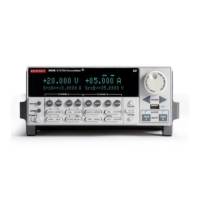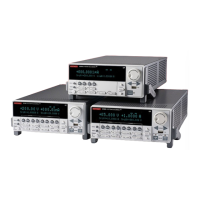4 -9
SECTION 4
FET Tests
Once the code has been placed in the instrument run-time 8.
memory, we can run it at any time simply by calling the func-
tion ‘FET_Thres_Fast()’. This can be done by typing the text
‘
FET _ Thres _ Fast()
’ after the active prompt in the
Instrument Console line of TSB.
In the program ‘9. FET_Thres_Fast().tsp’, the function
FET _
Thres _ Fast(vdssource, istart, istop,
isteps)
is created.
vdssource
• represents the voltage value on the drain-
source of the transistor
istart
• represents the start value for the drain current
sweep
istop
• represents the stop value for the drain current
sweep
isteps
• represents the number of steps in the current
sweep
If these values are left blank, the function will use the default
values given to the variables, but you can specify each variable
value by simply sending a number that is in-range in the func-
tion call. As an example, if you wanted to have the drain-source
voltage (V
DS
) be 0.25V, the drain current sweep start value at
0.20µA, the drain current sweep stop value at 2µA, and the
number of steps be 15, you would send
FET _ Thres _
Fast(0.25, 200E-9, 2E-6, 15)
to the instrument.
The sources will be enabled, and the collector current of the 10.
device will be measured.
Once the sweep has been completed, the data (V11.
DS
, V
T
, and I
D
)
will be presented in the Instrument Console window of TSB.
Note that the program reverses the polarity of the emitter cur-
rents in order to display true polarity.
4.5.7 Program 11B Description
Initially, the instrument is returned to default conditions. Next,
SMUB, which sources I
D
and measures V
T
, is programmed as
follows:
Source I•
11V compliance, autorange•
Local sense•
1 NPLC integration rate•
istart
• : 0.5µA
istop
• : 1µA
isteps
• : 10
Next, SMUA, which sources V
DS
, is configured in the following
manner:
Source V•
Remote sensing•
100mA compliance, autorange•
vdssource
• : 0.5V
Once the SMU channels have been configured, the sources values
are programmed to 0 and the outputs are enabled. The drain-
source voltage (V
DS
) is sourced and the drain current (I
D
) is
swept. At each point in the sweep, the threshold voltage (V
T
) is
measured.
The data is displayed in the Instrument Console window of the
TSB.
Note that both I
D
and V
T
values are corrected for proper polarity.
4.5.8 Modifying Program 11B
As written, the program tests for threshold voltages at 10 values
of I
D
between 0.5µA and 1µA in 10 increments. These values can
be changed to the required values simply by modifying the cor-
responding variables in the program.

